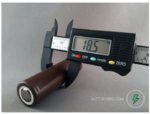- Likes
- 2,802
- Location
- Pennsylvania
There are a couple things I’d like to understand better about these batteries to give them the best chance of maximum life. They claim battery life at 1000 charge cycles which is being used interchangeably with 1000 hours, that’s assuming the average user is going to average an hour out of a charge. So that makes we wonder is it better to deplete the battery completely before charging or is frequent “top offs” not going to impact the battery life to any measurable degree? Obviously this wouldn’t be practical in many situations, but if for example I was only riding on my property a little each night during the week, I could run it down completely before charging if that was better for it in the long term.



